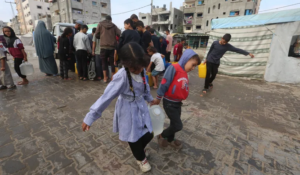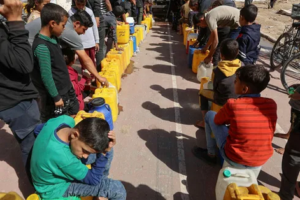In Gaza, Palestinians line up for hours to get just a few litres of water

A line at a water–filling station in Gaza on 10 November 2024
Jack Khoury reports in Haaretz on 14 November 2024:
Winter is getting closer, and it is about to pose another difficult challenge for the inhabitants of the Gaza Strip.
The approaching rainy season is an increasing concern for those who live in dilapidated buildings with ruined infrastructure or in tents, but on one particular issue it may provide relief: rainwater will provide inhabitants with fresh, less contaminated water, and allow them to fill up containers. A lucky few may locate a good, usable well and might secure their own independent source of water.
The water crisis is noticeable everywhere in Gaza. In one of the depressing photographs taken in recent weeks, children are seen using small cups to try to collect rainwater running in the streets.
Locals and displaced persons testify that they must wait hours to fill a bucket with water. One local, 18-year-old Hallil Al-Balawi, acquired only two liters of drinking water after waiting in a long line in front of the water–filling station at the Sheikh Radwan neighborhood, north of Gaza City. It takes Al-Balawi two or three hours of waiting in line to get his fill of water.
He then pours them into a small container for his mother to boil and sterilize. Sterilization, often undertaken by mothers, is a particularly important step in light of the medicine shortage and collapse of health services in Gaza. Two of Al-Balawi’s siblings, ages 9 and 7, suffered from colitis as a result of using contaminated water.
Al-Balawi’s mother, whose husband was killed in the war, says that it’s not the availability of water but rather its pervasive contamination from sewage and waste, following the destruction of infrastructure, that is the most pressing problem. She says that sterilization is not easy, as she has to maintain a burning fire for hours. This requires collecting flammable branches and foliage, as cooking gas is another rare commodity in Gaza.
As the Israeli military siege on the northern Gaza Strip lingers on, the water problems have grown worse. In Gaza City, many families struggle to get one bucket a day.
Gaza residents have been suffering from a limited water supply from even before the war. Gaza’s main source of water is the coastal aquifer, which fulfills most of the population’s needs with water drawn from wells around the enclave. Overuse of this source due to population growth has reduced the water level and increased salinity. As of now, after over a year of war, most water sources in Gaza are abandoned. According to Gaza’s information ministry, 700 wells around Gaza have been destroyed or rendered inoperable.

Children in line to fill buckets with water in northern Gaza during October 2024
Over the years, several seawater desalination plants have been set up in Gaza, funded by international donors and institutions, in order to provide drinkable water and to reduce dependence on the aquifer. These plants provide a limited amount of water insufficient to cover all the population’s needs. Even prior to the war, these plants were suffering from malfunctions due to electricity shortages and the difficulty in acquiring spare parts, due to the siege on Gaza. All of these plants have been disabled in the war. Moreover, since the war began, Israel has ceased supplying the limited amount of water it used to provide to Gaza.
Gaza City Hall Spokesperson Assam Al-Nabiyah says that water only reaches 40 percent of the city, as more than three fourths of the local wells have been damaged or destroyed, and most plumbing infrastructure has also been damaged. In a press release on Monday, the spokesperson added that water reaching residents does not meet all of their drinking, cooking and hygiene needs.
Even for people who have access to wells, retrieving drinking water is difficult. Mahmoud Al-Goul, a resident of Gaza City, says that pumping water is a huge challenge because using the pump requires fuel. The fuel is used to activate an electric generator that inhabitants use to pump water from an uncovered well in a house left uncompleted when the war started. He says, “There are about 20 families in the neighborhood where I live, and we split between ourselves the cost of the fuel bought on the black market.” He points out that fuel is very expensive, but that it’s worth it over using contaminated water.
Samir Zakout, a human rights activist at Al Mezan Center who has relocated to Deir al-Balah, explains in conversation with Haaretz that the growing pressure on water infrastructure is due to most of the displaced population concentrating in the “humanitarian area” in central Gaza. “In Deir al-Balah there are two desalination plants which do not provide enough water,” he says.
“I get pumped water once every 15 days, and this is salt water which is unusable for drinking or even for brushing your teeth, certainly not for hygiene,” he says, “We suddenly came to realize that a functioning toilet with running water is a crucial necessity. The public improvises toilets in cesspits, but there’s no way to take a shower. Even in summer, it was hard to get water for showers. All infrastructure is destroyed, and there’s no solution. Israel is asking residents to relocate to humanitarian areas, but maybe it, too – with it being an occupying, ruling force – will provide water to humanitarian areas?”
According to Zakout, at the beginning of the war it was possible to load water tanks on tractors and trucks and sell water for a few shekels per bottle. This option is now greatly reduced, and some have taken to selling water bottles from donkey-pulled carts. “And the situation in Gaza only grows worse every day,” he adds.
This article is reproduced in its entirety
